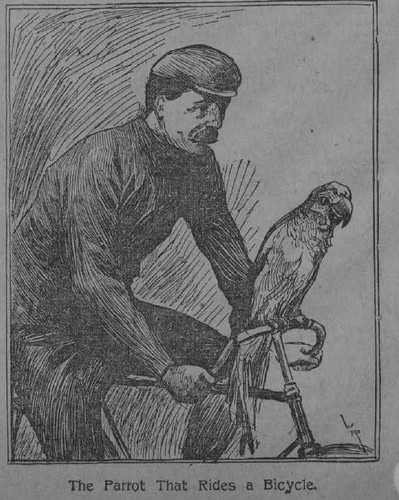
Sheet music from 1895 with cover photograph of woman riding bike
https://www.loc.gov/item/2017562127/
Title-The bicycle girl
Contributor Names
Meacham, F. W., composer.
Oddfellow, Avery, lyricist.
Schwalbach, Alex, dedicatee.
Created / Published-Brooklyn, N.Y. : Published by Hedenberg and Oakin, [1895] ©1897
Subject Headings
- Popular music--United States--To 1901
- Feminist music--United States
- Bicycles--Songs and music
Genre-Songs, Scores
Notes
- For voice and piano.
- Includes a photograph of a woman riding a bicycle.
- "Respectfully dedicated to Alex Schwalbach, Manager, Wilson Myers Company."
Medium-1 score (5 pages) : photograph ; 36 cm
Call Number/Physical Location-M1622 .M
Digital Id
hdl.loc.gov/loc.music/mussuffrage.mussuffrage-100007
Library of Congress Control Number-2017562127
Online Format-image
Description- For voice and piano. Includes a photograph of a woman riding a bicycle. "Respectfully dedicated to Alex Schwalbach, Manager, Wilson Myers Company."
LCCN Permalink
lccn.loc.gov/2017562127

Detail - just the photograph (click through to Flickr to see more detail)
The suffragette connection to cycling is made in this sheet music collection:
In 1896 Susan B. Anthony declared, "Let me tell what I think of bicycling. I think it has done more to emancipate women than anything else in the world." The Music Division's sheet music collections feature countless titles referencing and depicting the "new woman" or the "coming woman," frequently wearing bloomers and/or riding a bicycle. And Anthony was not the only suffragist to sing the bicycle's praises; in Elizabeth Cady Stanton's own words: "The bicycle will inspire women with more courage, self-respect, and self-reliance and will make the next generation more vigorous of mind and body; for feeble mothers do not produce great statesmen, scientists and scholars." To read more about the significance of the bicycle to the suffrage movement, see Sue Macy's book, Wheels of Change: How Women Rode the Bicycle to Freedom.
https://www.loc.gov/collections/womens-suffrage-sheet-music/articles-and-essays/highlighted-sheet-music-selections/
As with much photography of this period, this was shot in a studio, posed. One presumes (or at least hopes) that this young woman was in fact a cyclist and further that her pins are some kinds of awards for cycling, but it isn't certain (to me, at least).

















![Ride a Stearns [bicycle] and be content (1896)](http://farm9.staticflickr.com/8098/8486472025_27bf720e83.jpg)













